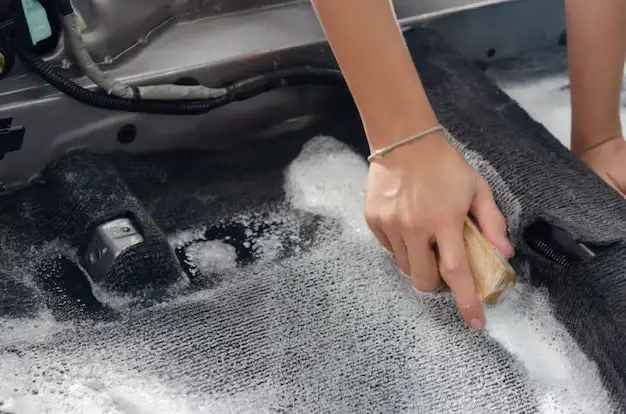Page Contents
Quick Answer
Yes, it is possible to replace the carpet in your car, but it can be a big project. The carpet is an important component in controlling noise and providing insulation, so replacing it requires removing seats and interior panels to access the old carpet and install new carpet. Many car owners choose to have a professional shop replace car carpet, but it can be done as a DIY project if you have the right tools, patience, and skills.
What Does the Car Carpet Do?
The carpet in a car serves several important functions:
- Noise reduction – Carpet helps muffle road noise and sounds from the engine and exhaust.
- Insulation – It provides a layer of insulation to maintain interior temperatures and protect occupants from heat and cold.
- Aesthetics – Carpet gives the interior a finished, quality look and allows for color customization.
- Traction – It provides grip underfoot for driver and passengers.
Factory carpet is designed specifically to meet the needs of each vehicle model. Replacement carpet should deliver the same qualities to properly protect and finish the interior.
When to Replace Car Carpet
Here are some signs that it may be time to replace old, worn car carpet:
- Fading, discoloration, or stains – Exposure to sunlight and dirt wears down carpet color and makes stains harder to remove.
- Holes, tears, unraveling – Foot traffic can cause rips, tears, and open seams in the carpet.
- Loose fitting – The backing and padding under carpet can deteriorate, causing a loose, ill-fitting carpet.
- Musty smells – Spills soak through carpet over time and cause mildew or mold smells.
- Too far gone – Severe damage from floods, accidents, or long-term wear may require full carpet replacement.
Replacing damaged, stained, or badly worn carpet can refresh the look and comfort of the interior.
Car Carpet Replacement Cost
The cost to replace car carpet will depend on:
- Vehicle make and model – More expensive cars typically have more carpet material and labor time.
- Shop rates in your area – Labor costs vary based on location and shop size.
- Extent of replacement – Just front carpet vs. full interior carpet replacement.
- Carpet quality – Basic carpet or upgraded, thicker carpet options.
As a rough estimate, expect to pay $200-600 or more for parts and labor. High-end cars or full carpet replacement kits could cost $1,000 or more.
Can I Replace Car Carpet Myself?
It’s possible for DIYers to tackle carpet replacement in their own garage, but be prepared for a time-consuming project. Here are some tips if you want to DIY it:
- Research the process for your specific car make and model year to know what needs removal and how to access the carpet.
- Allow plenty of time – it could take 10 hours or longer start to finish.
- Have helpers on hand for removal/install of heavy seats.
- Take photos during removal to help with re-assembly.
- Buy a complete replacement kit with tools & fasteners.
- Be extremely careful not to break interior clips and fasteners.
- Watch out for airbags, sensors, and wiring under the carpet.
Replacing car carpet takes patience and care. Attempting it with little experience could lead to damaging the car.
Steps to Replace Car Carpet
The basic process for replacing car carpet involves:
- Remove interior panels – Dashboard, center console, door panels/handles, and anything covering the old carpet.
- Take out seats – Front and rear seats usually must be removed to access carpet.
- Lift out old carpet – Pry up old carpet carefully from edges and cut old material away from rubber grommets.
- Clean floor – Vacuum and clean the now-exposed floor to remove dirt, stray nails, etc.
- Install new padding – Lay down new padding, secured with spray adhesive.
- Install new carpet – Place in new carpet, tucking edges into trim channels and openings.
- Replace trim – Reinstall sill plates, grommets, insulation, and any under-carpet accessories.
- Reassemble interior – Carefully replace seats, panels, handles using photos as a guide.
Proper tools, patience, and care are needed at each step. Rushed removal can damage trim pieces and fittings. Take photographs to help with correct reassembly.
Professional vs. DIY Carpet Replacement
| Professional Shop | DIY |
|---|---|
|
|
DIY carpet replacement can save money but requires time and the risk of damaging components. For most car owners, having a professional shop replace the carpet is worth the cost.
Choosing New Car Carpet
When buying new carpet, you’ll want carpet intended for automotive use. Here are some factors to consider:
- Fiber type – Polyester and nylon are common. Nylon is more durable.
- Padding – Should match OEM thickness; too thin or thick will not fit right.
- Color – Match original or customize with a new color.
- Molded vs. flat – Molded carpet is contoured; flat is easier for DIY.
- Match model year – Carpet should fit the specific make, model, and year.
Consult a car parts supplier to find the right carpet kit for your car’s year, make, and model. Buying a complete kit helps ensure proper fit.
Conclusion
Replacing worn, damaged car carpet helps refresh the look and comfort of the interior. While it’s possible to do as a DIY project, the time-consuming process and risk of damaging trim or components often makes hiring a professional the better option. For most car owners, the hundreds of dollars to have a shop replace the carpet is money well spent compared to the headaches and uncertainties of tackling this big job themselves. With the right quality carpet kit and experienced installer, you can give fresh life to your car’s interior.
